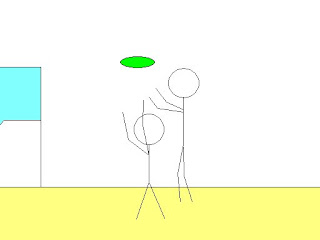 This past week we played Ultimate Frisbee for PE in the Upper Gym. It's a very intense game. It also has a lot of physics in it, but I can't yet identify all of what's going on.
This past week we played Ultimate Frisbee for PE in the Upper Gym. It's a very intense game. It also has a lot of physics in it, but I can't yet identify all of what's going on. Anyway the first thing is the change in momentum when the frisbee is caught. Once the frisbee is thrown in the air, it has momentum, which is mass multiplied with velocity. The change in momentum is the velocity change times the mass. I don't know the frisbee's original velocity when it's flying in the air, but it goes from that to zero m/s, thus changing the frisbee's momentum. Because the frisbee experienced a change in momentum, it also felt impulse, which is force multiplied with time.
During the game, people sometimes collided with each other. For example, a girl was trying to catch the frisbee and score a point for her team, but then the boy on the other team jumped up in the air and caught it before she could. Then when he came down from his jump, he hit her and she fell down. She was stationary, so when he came down, his momentum is transferred to her because momentum is conserved in collisions.
For another example, I tried to intercept the frisbee from reaching the opposite team, so I ran up behind this one guy and he moved back unexpectantly. I had stopped running at that point, so when he moved back, I fell. He had more momentum than me, so I failed to intercept the frisbee. It was also a bouncy collision because he did not fall with me. If he had, then he would not have caught the frisbee.
Ultimate frisbee is a good game, especially when your team wins. By the way, that rectangle on the side of the picture that's blue and white on the inside is supposed to be the door with the stairs that go down by the I Building.
